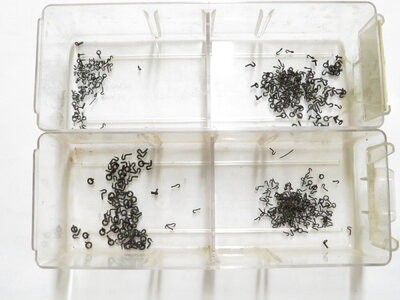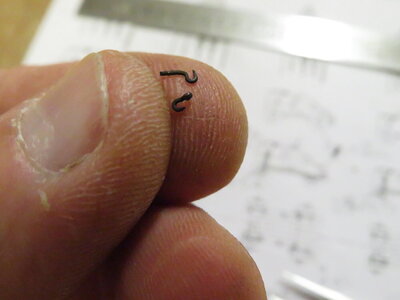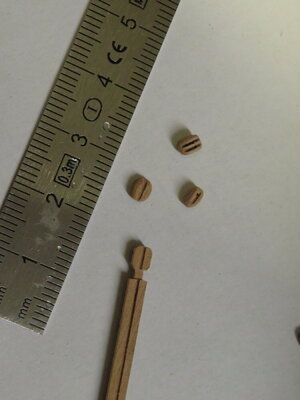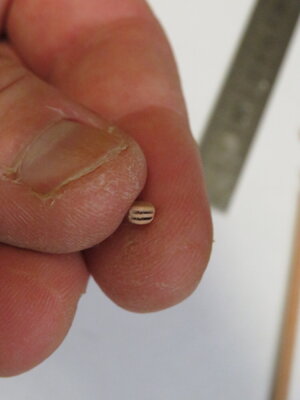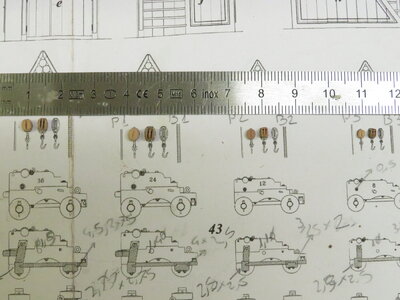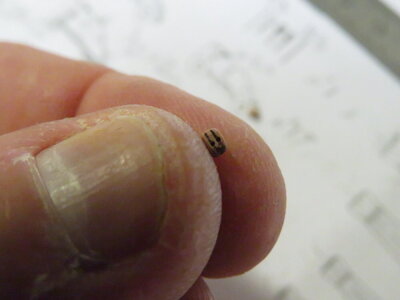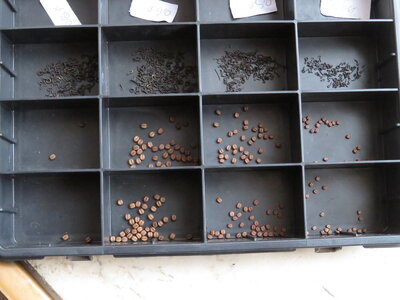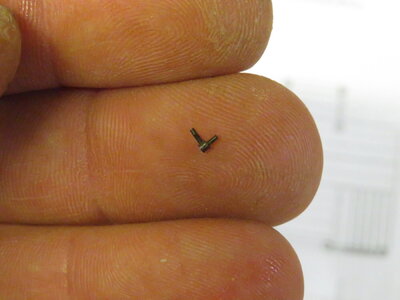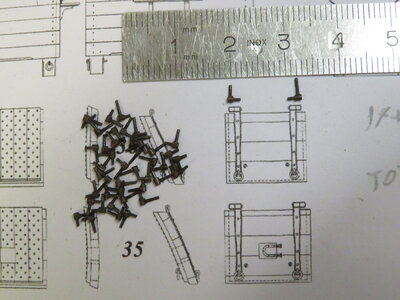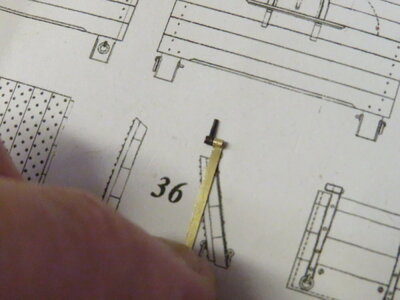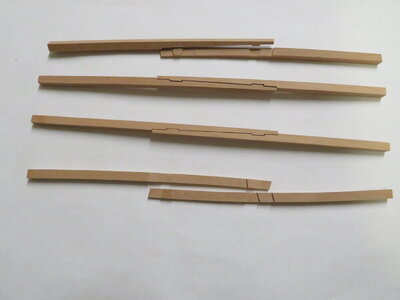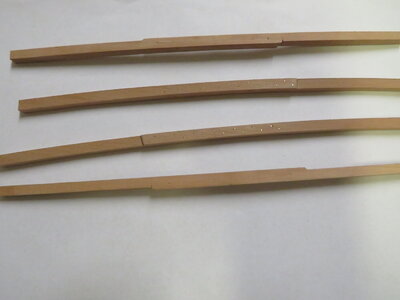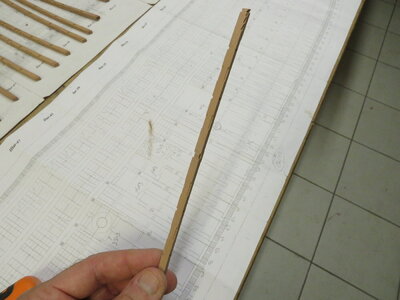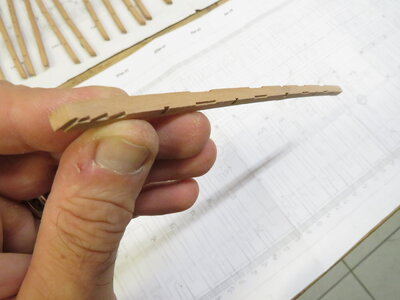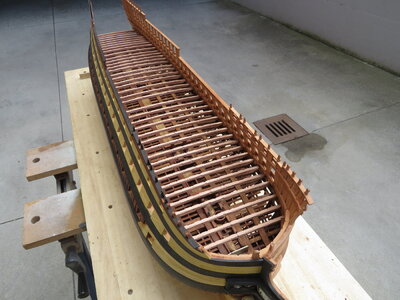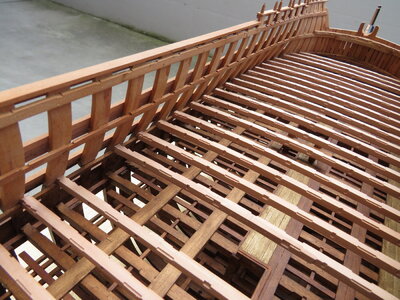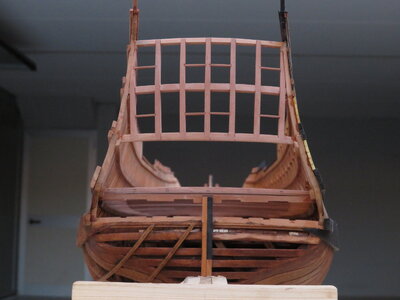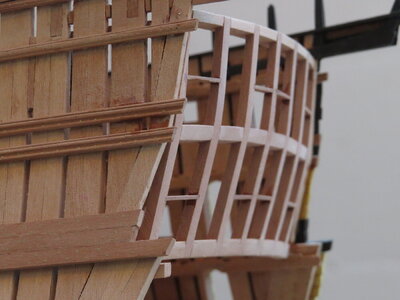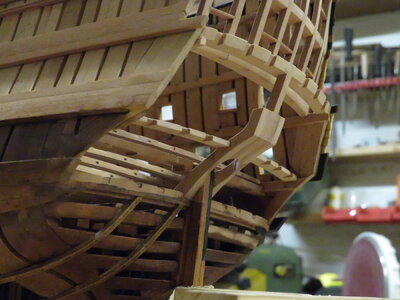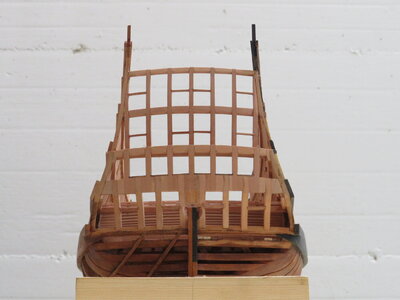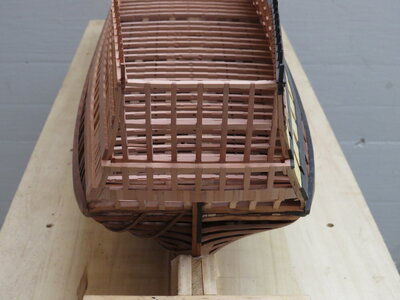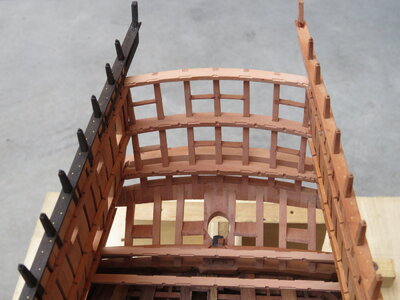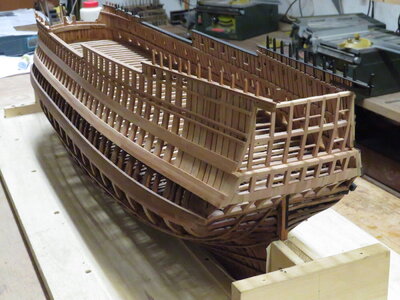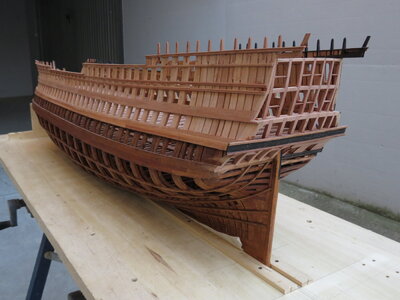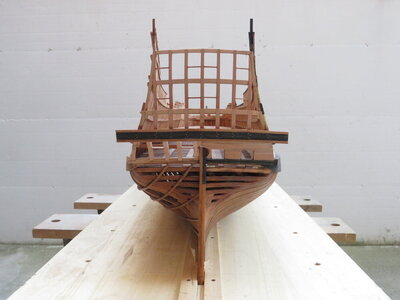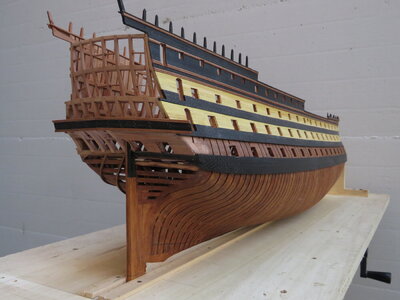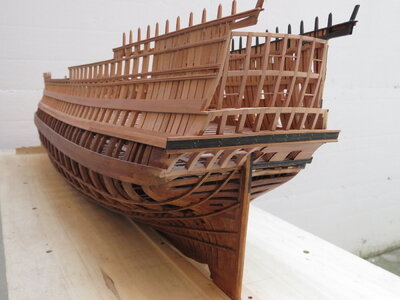-

Win a Free Custom Engraved Brass Coin!!!
As a way to introduce our brass coins to the community, we will raffle off a free coin during the month of August. Follow link ABOVE for instructions for entering.
-

PRE-ORDER SHIPS IN SCALE TODAY!
The beloved Ships in Scale Magazine is back and charting a new course for 2026!
Discover new skills, new techniques, and new inspirations in every issue.
NOTE THAT OUR FIRST ISSUE WILL BE JAN/FEB 2026
You are using an out of date browser. It may not display this or other websites correctly.
You should upgrade or use an alternative browser.
You should upgrade or use an alternative browser.
LE COMMERCE DE MARSEILLE SCALA 1/72
- Thread starter MICHELE PADOAN
- Start date
- Watchers 42
- Joined
- Sep 28, 2018
- Messages
- 250
- Points
- 373

- Joined
- Sep 28, 2018
- Messages
- 250
- Points
- 373

Magari, una volta... ora per questi lavoretti devo usare le lenti d'ingrandimentoMy friend, you must have a perfect 20/20 vision or even more, a Superman vision.
Super crisp!
- Joined
- Sep 28, 2018
- Messages
- 250
- Points
- 373

very accurate work The cutting of the different notches are very precise work
Your model is every bit as good as Amalio's Montanes - and at a significantly smaller scale! For me, I file this one under the mental category: Dare to Dream.
I think that the reason I am so captivated by this particular model and subject is that she seems to define, for me, a transitional phase in French naval architecture, where there still remains an elegance of line, fore and aft, and a pleasing sheer-line and tumblehome. There's a significant mid-section of the hull that is straight-sided, which portends the next phase of war-ship design as more purely functional vehicles of death and destruction. Yet, that still does not detract from the overall elegance of the ship. She's still very much a thing of beauty and inspiration.
Fantastic
My dear Michele. I just spent the most wonderful two hours reviewing this build log. Perhaps you have become accustomed to all the accolades but indulge me as I add mine. Your work is breathtaking for its precision. The wood-shaping and joinery are unmatched. Every element has been lovingly given the necessary attention with seemingly no regard for the expense of time. The recent addition of ironworks verifies (along with the earlier exhibition of carving) that no aspect of this construction has eclipsed your talent. It delights me beyond words to witness your gift. With humility I can only thank you for sharing your work. Exquisite hardly covers it.
- Joined
- Sep 28, 2018
- Messages
- 250
- Points
- 373

Beautifully crafted, Michele!!! I really like the color of the frames, they are the exact color and tone I love. You may have alredy answered this question in the past, what is the recipe of the stain (if this sain) or paint mix so you can archive these results. It may be hard to give the proportions, but at least if you can provide the components - that would be great.
Italian
Splendidamente realizzato, Michele!!! Mi piace molto il colore delle montature, sono esattamente il colore e il tono che amo. Potresti aver già risposto a questa domanda in passato, qual è la ricetta della macchia (se questa sa) o della miscela di vernice in modo da poter archiviare questi risultati. Potrebbe essere difficile dare le proporzioni, ma almeno se puoi fornire i componenti, sarebbe fantastico.
Italian
Splendidamente realizzato, Michele!!! Mi piace molto il colore delle montature, sono esattamente il colore e il tono che amo. Potresti aver già risposto a questa domanda in passato, qual è la ricetta della macchia (se questa sa) o della miscela di vernice in modo da poter archiviare questi risultati. Potrebbe essere difficile dare le proporzioni, ma almeno se puoi fornire i componenti, sarebbe fantastico.
- Joined
- Sep 28, 2018
- Messages
- 250
- Points
- 373

Ciao, ti mando il link dove ho scritto tutto il procedimento del trattamento.Splendidamente realizzato, Michele!!! Mi piace molto il colore delle montature, sono esattamente il colore e il tono che amo. Potresti aver già risposto a questa domanda in passato, qual è la ricetta della macchia (se questa sa) o della miscela di vernice in modo da poter archiviare questi risultati. Potrebbe essere difficile fornire le proporzioni, ma almeno se puoi fornire i componenti, sarebbe fantastico.
italiano
Splendidamente realizzato, Michele!!! Mi piace molto il colore delle montature, sono esattamente Si potrebbe aver già risposto a questa domanda in passato, qual è la ricetta della macchia (se questa sa) o della miscela di vernice in modo da poter archiviare questi risultati. Potrebbe essere osare le proporzioni, ma almeno se puoi fornire i componenti, sarebbe fantastico.
English
Below, is the link where I wrote the whole procedure of the treatment.
Cerca l-arsenale.forumattivo.com
Forum l-arsenale.forumattivo.com Forum gratis : Dai modellisti per i modellisti. . . idee ed esperienza a disposizione di tutti Forum AreaLotto90 : Forum amatoriale sul gioco del lotto.
Grazie mille, Michele. Purtroppo il link l'hai fornito solo per accedere al forum italiano. Immagino che tu debba essere un membro del forum per leggere. È possibile copiare e incollare le informazioni dal tuo post? Grazie molto.Ciao, ti mando il link dove ho scritto tutto il procedimento del trattamento.
Thank You so much, Michele. Unfortunately, the link you provided only to log in on the Italian forum. I guess you have to be a member of the forum in order to read. Is it possible you can copy and paste the information from your posting? Many thanks.
- Joined
- Sep 28, 2018
- Messages
- 250
- Points
- 373

Ciao, sì, per accedere ad alcuni link devi essere iscritto.Grazie mille, Michele. Purtroppo il link l'hai fornito solo per accedere al forum italiano. Immagine che tu deve essere un membro del forum per leggere. È possibile incollare le informazioni dal tuo post? Grazie molto.
Grazie mille, Michele. Purtroppo il link l'hai fornito solo per accedere al forum italiano. Immagino che tu debba essere un membro del forum per leggere. È possibile copiare e incollare le informazioni dal tuo post? Grazie molto.
Ti copio io le informazioni.
"Buongiorno marinai, come ormai ben sapete ed avrete notato, dopo la mia prima esperienza con le due sezioni della Volage, anche per il mio ultimo lavoro, Le Commerce de Marseille, farò un trattamento di vari passaggi di gommalacca, bitume e cera per dare quell'aspetto un po' vissuto. Il lavoro è un po' più complicato del precedente vista la particolarità dello scafo e le dimensioni più necessarie per poter effettuare queste operazioni. Ma è anche vero che ho alle spalle l'esperienza di un lavoro già fatto in precedenza e che mi è servito per portare dei miglioramenti.
Ora, visto con altri in molti a chiedermi sia negli forum che su facebook, come sia arrivato a questo risultato, voglio descrivere qui nel nostro risultato, in modo semplice, questo "mio" metodo, mio nel senso che per quanto possa essere a conoscenza, ora non ricordo nessun modellista dei giorni nostri che abbia fatto questo trattamento nei suoi modelli. Di certo non scopro io il bitume di giudea, visto che per secoli è stato usato per la fotografia e nel modellismo come agente antichizzante. A dire il vero la mia all'inizio è stata una decisione "coraggiosa" in quanto sono passato dal modello "perfetto", pulito, precisino, quasi da "soprammobile", qualcosa di vissuto, vivo. Una scelta, la mia che si discosta e va fuori da tutte le "norme" viste fino ad ora nell'arsenale, dove purtroppo secondo il mio punto di vista è diventata per molti più una regola fissa che non un apprendimento ed una voglia continua di migliorarsi. Non così se ci sono altri modelli simili al mio, sicuramente sarà punto di discussione, di critiche o apprezzamenti, chi lo sa. Una cosa è sicura, ancora una volta ho voluto seguire il mio istinto. Sia ben chiaro, non mi invento nulla, ma creo privilegiando il piacere di costruire una veridicità in base alla mia conoscenza e capacità.
Ora passiamo al dunque. Innanzitutto come prima cosa va data una mano di gommalacca che farà da isolante tra legno e bitume. Si proprio così perchè il bitume dato direttamente sul legno, lo annerisce brutalmente. Una volta asciutta la gommalacca si procede col secondo passaggio di bitume diluito nella cera. Bisogna ottenere una consistenza tale che ti possa permettere di lavorare e che non asciughi troppo rapidamente. La cera va stesa e poi tolta quella in eccesso avendo cura di entrare nei piccoli dettagli. Io uso pennelli soffici e piccoli batuffoli per poter entrate dove che con un semplice tampone è impossibile. Non è semplice, certamente ci sarà prima delle prove come ho fatto io, e solo dopo vari tentativi, puoi decidere come agire. Dovrete limitarvi ad un solo passaggio, perchè anche una seconda mano, sia pur leggera di bitume, scurirà non poco il legno. Credo di essere stato chiaro, non è semplice ma prendere regole, basta rispettare queste due piccole principali, poi sta a voi applicarvi ma soprattutto scegliere, io ho sempre fatto le mie scelte.
Se vogliamo cercare di riprodurre alla perfezione una nave e se vogliamo che il nostro modello assomigli più alla realtà che ad un soprammobile, ecco che dobbiamo farlo più vivo possibile dandogli un'anima. Non basta essere degli abili modellisti, ma occorrono anni di esperienza e pratica per scoprire ciò che più risalta queste qualità. Io mi sto applicando da anni nel trovare tecniche e soluzioni alternative a quello che per anni si è sempre praticato seguendo alla lettera come fosse la sacra bibbia. Non mi sono mai fermato nella ricerca di usare anche nuovi materiali che impreziosiscono il nostro modello aggiungendo oltre alle capacità modellistiche anche la qualità del lavoro ( lo sto facendo anche per le decorazioni usando l'osso bovino). Concetti che mi hanno ispirato e mi hanno portato alla ricerca appunto di queste cose e quindi alla pratica ed il continuo scambio di idee e riflessioni con i miei amici modellisti, con tutti voi. È così che si impara, è così che si migliora. Siate voi i critici di voi stessi, voi siete i giudici dei vostri modelli. Lasciate perdere tutto quello che gira intorno e guardate sempre dal basso della vostra umiltà, la strada da percorrere è sempre in salita ma non per questo irraggiungibile. Non esistono nè maestri nè professori. Esistono le critiche, quelle costruttive, ed i consigli, quelle sono le cose che servono e fanno bene al modellismo. voi siete i giudici dei vostri modelli. Lasciate perdere tutto quello che gira intorno e guardate sempre dal basso della vostra umiltà, la strada da percorrere è sempre in salita ma non per questo irraggiungibile. Non esistono nè maestri nè professori. Esistono le critiche, quelle costruttive, ed i consigli, quelle sono le cose che servono e fanno bene al modellismo. voi siete i giudici dei vostri modelli. Lasciate perdere tutto quello che gira intorno e guardate sempre dal basso della vostra umiltà, la strada da percorrere è sempre in salita ma non per questo irraggiungibile. Non esistono nè maestri nè professori. Esistono le critiche, quelle costruttive, ed i consigli, quelle sono le cose che servono e fanno bene al modellismo.
Per quanto riguarda il discorso aperto da Riccardo sulla Taverna dei filibustieri, scrivo anch'io giusto due parole qui, conoscenza e divulgazione, questo è il forum. E postate i vostri lavori, visto che pochi di voi lo fanno, mettete foto, anche così gli altri possono imparare. Non si tratta di accomodarsi in mostra, è vero che fanno piacere i complimenti , ma per migliorare più di quelli, si ha bisogno di applicazione."
Se ti fai piacere ti puoi iscrivere tranquillamente nel nostro forum, ci sono tutti i miei lavori e spiegazioni, ed anche quelli di altri bravi modellisti.
google translation:
hello, yes, to access some links you must be registered.
I'll copy the information to you.
"Hello sailors, as you well know by now and you will have noticed, after my first experience with the two sections of the Volage, also for my latest work, Le Commerce de Marseille, I will do a treatment of various passages of shellac, bitumen and wax to give that slightly lived-in aspect. The work is a little more complicated than the previous one due to the peculiarity of the hull and the more necessary dimensions to be able to carry out these operations. But it is also true that I have the experience of a job already done behind me previously and that I needed to bring improvements.
Now, seen with many others asking me both in the forums and on facebook, how it came to this result, I want to describe here in our result, in a simple way, this "my" method, mine in the sense that as far as I can know , now I don't remember any modern day model maker who did this treatment in his models. I certainly do not discover the Judean bitumen, since for centuries it has been used for photography and in model making as an antiquing agent. To tell the truth, at the beginning mine was a "courageous" decision as I went from the "perfect" model, clean, to be precise, almost from an "ornament", something lived, alive. A choice, mine that deviates and goes beyond all the "norms" seen up to now in the arsenal, where unfortunately according to my point of view it has become for many more a fixed rule than a learning and a continuous desire to improve. Not so if there are other models similar to mine, surely it will be a point of discussion, criticism or appreciation, who knows. One thing is sure, once again I wanted to follow my instincts. Let me be clear, I don't invent anything, but I create by privileging the pleasure of building a truth based on my knowledge and ability.
Now let's get to the point. First of all, a coat of shellac must be given first, which will act as an insulator between wood and bitumen. Yes, just like that because the bitumen given directly to the wood brutally blackens it. Once the shellac is dry, proceed with the second passage of bitumen diluted in the wax. You need to get a consistency that can allow you to work and does not dry too quickly. The wax should be spread and then removed the excess, taking care to go into the small details. I use soft brushes and small wads to be able to enter where that with a simple swab is impossible. It is not easy, certainly there will be tests beforehand as I did, and only after several attempts, you can decide how to act. You will have to limit yourself to a single step, because even a second coat, albeit light of bitumen, will darken the wood considerably. I think I was clear, it's not easy but to take rules, just respect these two small main ones, then it's up to you to apply yourselves but above all to choose, I have always made my choices.
If we want to try to perfectly reproduce a ship and if we want our model to look more like reality than an ornament, we have to make it as alive as possible by giving it a soul. It is not enough to be skilled model makers, but it takes years of experience and practice to discover what stands out most of these qualities. For years I have been applying myself in finding alternative techniques and solutions to what has always been practiced for years following to the letter as if it were the Holy Bible. I have never stopped in the search to also use new materials that embellish our model by adding in addition to the modeling skills also the quality of the work (I am also doing it for the decorations using bovine bone). Concepts that inspired me and led me to research precisely these things and therefore to practice and the continuous exchange of ideas and reflections with my model-making friends, with all of you. This is how you learn, this is how you improve. Be your own critics, you are the judges of your role models. Forget everything that goes around and always look at your humility from below, the way to go is always uphill but not unattainable. There are neither teachers nor professors. There are criticisms, constructive ones, and advice, those are the things that are needed and are good for model making. you are the judges of your models. Forget everything that goes around and always look at your humility from below, the way to go is always uphill but not unattainable. There are neither teachers nor professors. There are criticisms, constructive ones, and advice, those are the things that are needed and are good for model making. you are the judges of your models. Forget everything that goes around and always look at your humility from below, the way to go is always uphill but not unattainable. There are neither teachers nor professors. There are criticisms, constructive ones, and advice, those are the things that are needed and are good for model making.
As for the speech opened by Riccardo on the tavern of the freebooters, I too write just two words here, knowledge and disclosure, this is the forum. And post your work, since few of you do, post photos, even so others can learn. It is not a question of sitting on the show, it is true that compliments are pleasing, but to improve more than that, you need application. "
If you like, you can easily subscribe to our forum, there are all my works and explanations, and also those of other good modelers.
hello, yes, to access some links you must be registered.
I'll copy the information to you.
"Hello sailors, as you well know by now and you will have noticed, after my first experience with the two sections of the Volage, also for my latest work, Le Commerce de Marseille, I will do a treatment of various passages of shellac, bitumen and wax to give that slightly lived-in aspect. The work is a little more complicated than the previous one due to the peculiarity of the hull and the more necessary dimensions to be able to carry out these operations. But it is also true that I have the experience of a job already done behind me previously and that I needed to bring improvements.
Now, seen with many others asking me both in the forums and on facebook, how it came to this result, I want to describe here in our result, in a simple way, this "my" method, mine in the sense that as far as I can know , now I don't remember any modern day model maker who did this treatment in his models. I certainly do not discover the Judean bitumen, since for centuries it has been used for photography and in model making as an antiquing agent. To tell the truth, at the beginning mine was a "courageous" decision as I went from the "perfect" model, clean, to be precise, almost from an "ornament", something lived, alive. A choice, mine that deviates and goes beyond all the "norms" seen up to now in the arsenal, where unfortunately according to my point of view it has become for many more a fixed rule than a learning and a continuous desire to improve. Not so if there are other models similar to mine, surely it will be a point of discussion, criticism or appreciation, who knows. One thing is sure, once again I wanted to follow my instincts. Let me be clear, I don't invent anything, but I create by privileging the pleasure of building a truth based on my knowledge and ability.
Now let's get to the point. First of all, a coat of shellac must be given first, which will act as an insulator between wood and bitumen. Yes, just like that because the bitumen given directly to the wood brutally blackens it. Once the shellac is dry, proceed with the second passage of bitumen diluted in the wax. You need to get a consistency that can allow you to work and does not dry too quickly. The wax should be spread and then removed the excess, taking care to go into the small details. I use soft brushes and small wads to be able to enter where that with a simple swab is impossible. It is not easy, certainly there will be tests beforehand as I did, and only after several attempts, you can decide how to act. You will have to limit yourself to a single step, because even a second coat, albeit light of bitumen, will darken the wood considerably. I think I was clear, it's not easy but to take rules, just respect these two small main ones, then it's up to you to apply yourselves but above all to choose, I have always made my choices.
If we want to try to perfectly reproduce a ship and if we want our model to look more like reality than an ornament, we have to make it as alive as possible by giving it a soul. It is not enough to be skilled model makers, but it takes years of experience and practice to discover what stands out most of these qualities. For years I have been applying myself in finding alternative techniques and solutions to what has always been practiced for years following to the letter as if it were the Holy Bible. I have never stopped in the search to also use new materials that embellish our model by adding in addition to the modeling skills also the quality of the work (I am also doing it for the decorations using bovine bone). Concepts that inspired me and led me to research precisely these things and therefore to practice and the continuous exchange of ideas and reflections with my model-making friends, with all of you. This is how you learn, this is how you improve. Be your own critics, you are the judges of your role models. Forget everything that goes around and always look at your humility from below, the way to go is always uphill but not unattainable. There are neither teachers nor professors. There are criticisms, constructive ones, and advice, those are the things that are needed and are good for model making. you are the judges of your models. Forget everything that goes around and always look at your humility from below, the way to go is always uphill but not unattainable. There are neither teachers nor professors. There are criticisms, constructive ones, and advice, those are the things that are needed and are good for model making. you are the judges of your models. Forget everything that goes around and always look at your humility from below, the way to go is always uphill but not unattainable. There are neither teachers nor professors. There are criticisms, constructive ones, and advice, those are the things that are needed and are good for model making.
As for the speech opened by Riccardo on the tavern of the freebooters, I too write just two words here, knowledge and disclosure, this is the forum. And post your work, since few of you do, post photos, even so others can learn. It is not a question of sitting on the show, it is true that compliments are pleasing, but to improve more than that, you need application. "
If you like, you can easily subscribe to our forum, there are all my works and explanations, and also those of other good modelers.


